Tesco: Background, Products, and Competitive Analysis
VerifiedAdded on 2023/01/11
|12
|4079
|32
AI Summary
This report provides an overview of Tesco, including its background, products, and competitive analysis using Porter's five forces model. It also discusses the value chain and how Tesco can use innovative ideas to improve its business process and competitive position.
Contribute Materials
Your contribution can guide someone’s learning journey. Share your
documents today.
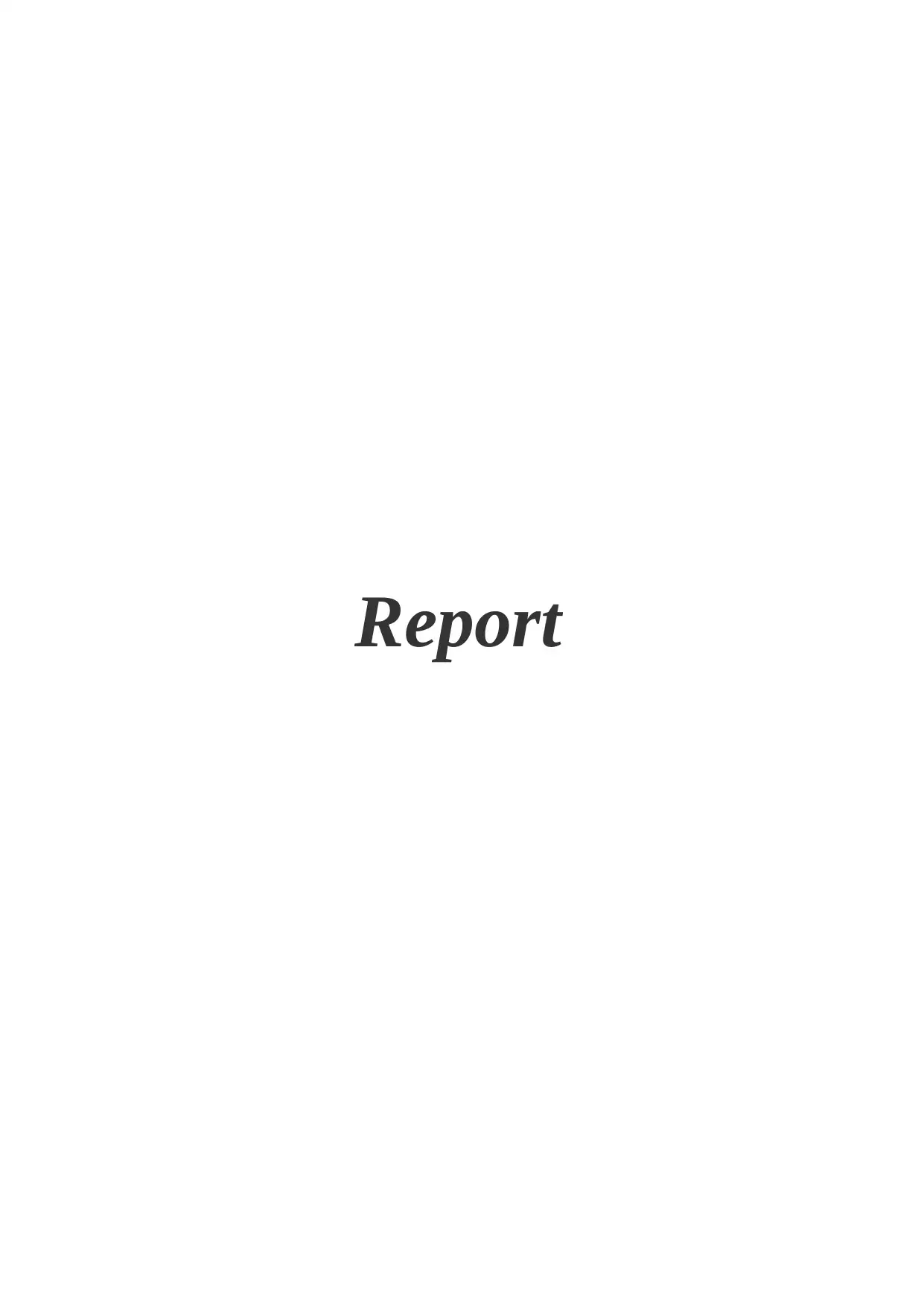
Report
Secure Best Marks with AI Grader
Need help grading? Try our AI Grader for instant feedback on your assignments.
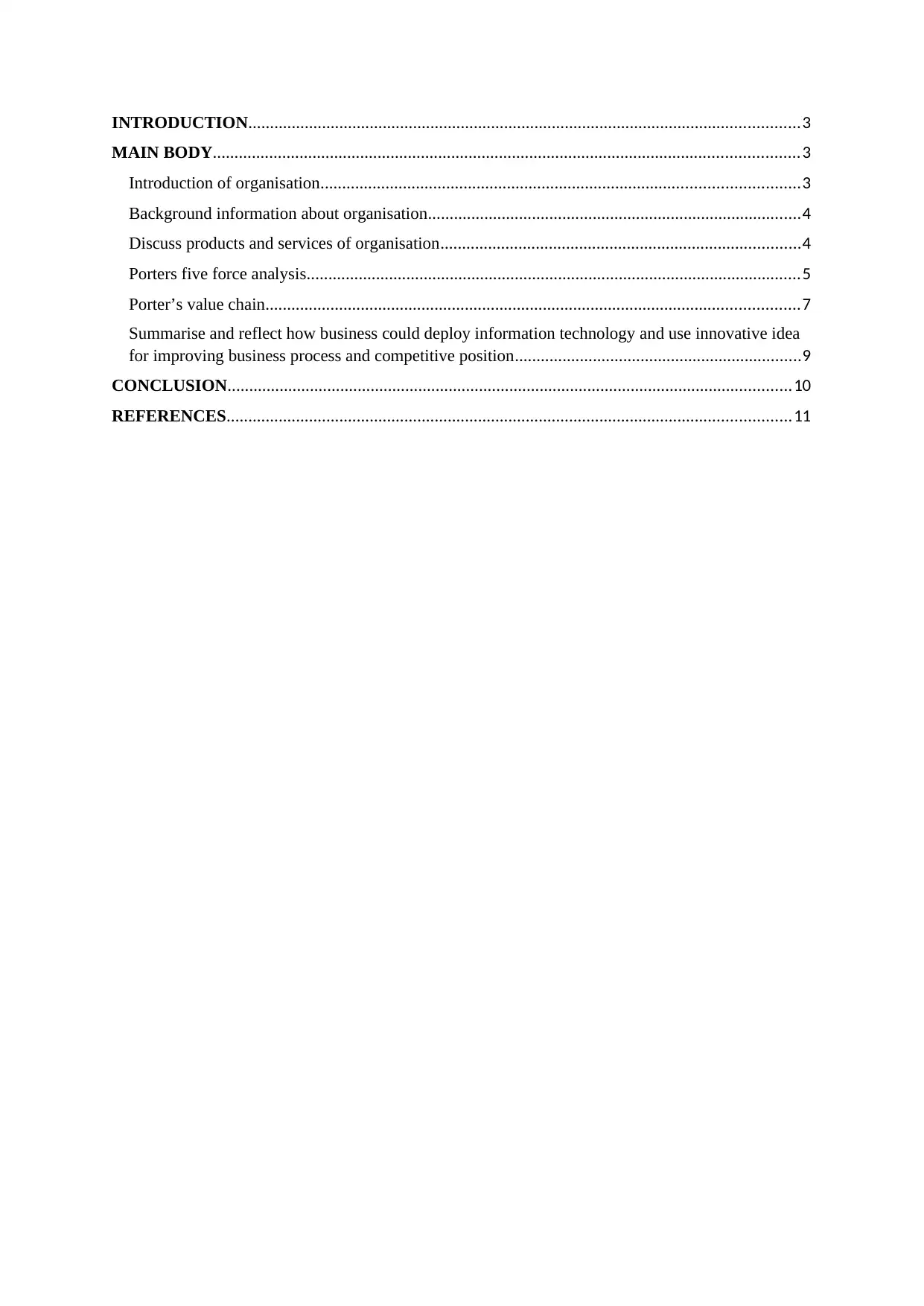
INTRODUCTION...............................................................................................................................3
MAIN BODY.......................................................................................................................................3
Introduction of organisation..............................................................................................................3
Background information about organisation......................................................................................4
Discuss products and services of organisation...................................................................................4
Porters five force analysis..................................................................................................................5
Porter’s value chain...........................................................................................................................7
Summarise and reflect how business could deploy information technology and use innovative idea
for improving business process and competitive position..................................................................9
CONCLUSION..................................................................................................................................10
REFERENCES..................................................................................................................................11
MAIN BODY.......................................................................................................................................3
Introduction of organisation..............................................................................................................3
Background information about organisation......................................................................................4
Discuss products and services of organisation...................................................................................4
Porters five force analysis..................................................................................................................5
Porter’s value chain...........................................................................................................................7
Summarise and reflect how business could deploy information technology and use innovative idea
for improving business process and competitive position..................................................................9
CONCLUSION..................................................................................................................................10
REFERENCES..................................................................................................................................11
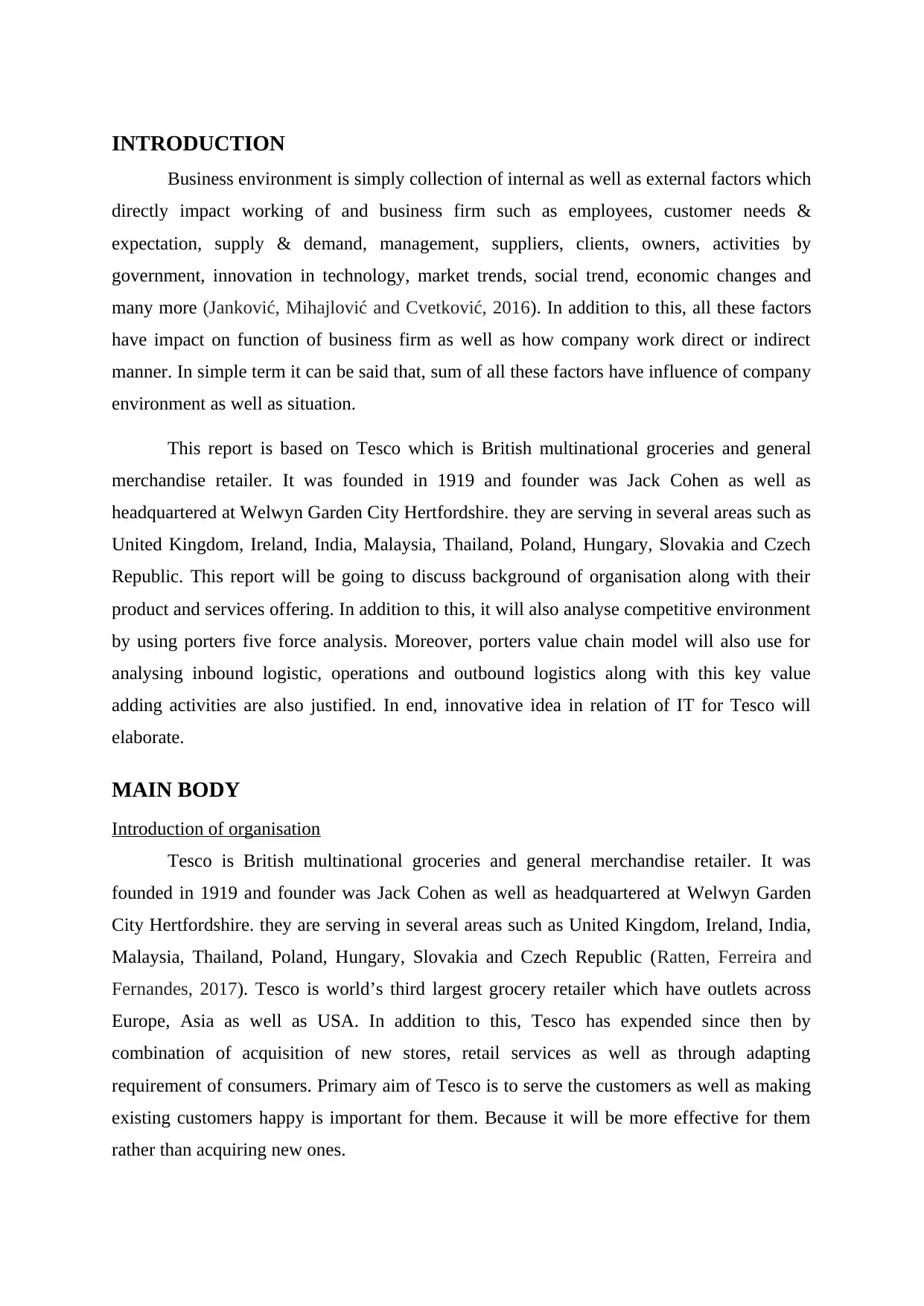
INTRODUCTION
Business environment is simply collection of internal as well as external factors which
directly impact working of and business firm such as employees, customer needs &
expectation, supply & demand, management, suppliers, clients, owners, activities by
government, innovation in technology, market trends, social trend, economic changes and
many more (Janković, Mihajlović and Cvetković, 2016). In addition to this, all these factors
have impact on function of business firm as well as how company work direct or indirect
manner. In simple term it can be said that, sum of all these factors have influence of company
environment as well as situation.
This report is based on Tesco which is British multinational groceries and general
merchandise retailer. It was founded in 1919 and founder was Jack Cohen as well as
headquartered at Welwyn Garden City Hertfordshire. they are serving in several areas such as
United Kingdom, Ireland, India, Malaysia, Thailand, Poland, Hungary, Slovakia and Czech
Republic. This report will be going to discuss background of organisation along with their
product and services offering. In addition to this, it will also analyse competitive environment
by using porters five force analysis. Moreover, porters value chain model will also use for
analysing inbound logistic, operations and outbound logistics along with this key value
adding activities are also justified. In end, innovative idea in relation of IT for Tesco will
elaborate.
MAIN BODY
Introduction of organisation
Tesco is British multinational groceries and general merchandise retailer. It was
founded in 1919 and founder was Jack Cohen as well as headquartered at Welwyn Garden
City Hertfordshire. they are serving in several areas such as United Kingdom, Ireland, India,
Malaysia, Thailand, Poland, Hungary, Slovakia and Czech Republic (Ratten, Ferreira and
Fernandes, 2017). Tesco is world’s third largest grocery retailer which have outlets across
Europe, Asia as well as USA. In addition to this, Tesco has expended since then by
combination of acquisition of new stores, retail services as well as through adapting
requirement of consumers. Primary aim of Tesco is to serve the customers as well as making
existing customers happy is important for them. Because it will be more effective for them
rather than acquiring new ones.
Business environment is simply collection of internal as well as external factors which
directly impact working of and business firm such as employees, customer needs &
expectation, supply & demand, management, suppliers, clients, owners, activities by
government, innovation in technology, market trends, social trend, economic changes and
many more (Janković, Mihajlović and Cvetković, 2016). In addition to this, all these factors
have impact on function of business firm as well as how company work direct or indirect
manner. In simple term it can be said that, sum of all these factors have influence of company
environment as well as situation.
This report is based on Tesco which is British multinational groceries and general
merchandise retailer. It was founded in 1919 and founder was Jack Cohen as well as
headquartered at Welwyn Garden City Hertfordshire. they are serving in several areas such as
United Kingdom, Ireland, India, Malaysia, Thailand, Poland, Hungary, Slovakia and Czech
Republic. This report will be going to discuss background of organisation along with their
product and services offering. In addition to this, it will also analyse competitive environment
by using porters five force analysis. Moreover, porters value chain model will also use for
analysing inbound logistic, operations and outbound logistics along with this key value
adding activities are also justified. In end, innovative idea in relation of IT for Tesco will
elaborate.
MAIN BODY
Introduction of organisation
Tesco is British multinational groceries and general merchandise retailer. It was
founded in 1919 and founder was Jack Cohen as well as headquartered at Welwyn Garden
City Hertfordshire. they are serving in several areas such as United Kingdom, Ireland, India,
Malaysia, Thailand, Poland, Hungary, Slovakia and Czech Republic (Ratten, Ferreira and
Fernandes, 2017). Tesco is world’s third largest grocery retailer which have outlets across
Europe, Asia as well as USA. In addition to this, Tesco has expended since then by
combination of acquisition of new stores, retail services as well as through adapting
requirement of consumers. Primary aim of Tesco is to serve the customers as well as making
existing customers happy is important for them. Because it will be more effective for them
rather than acquiring new ones.
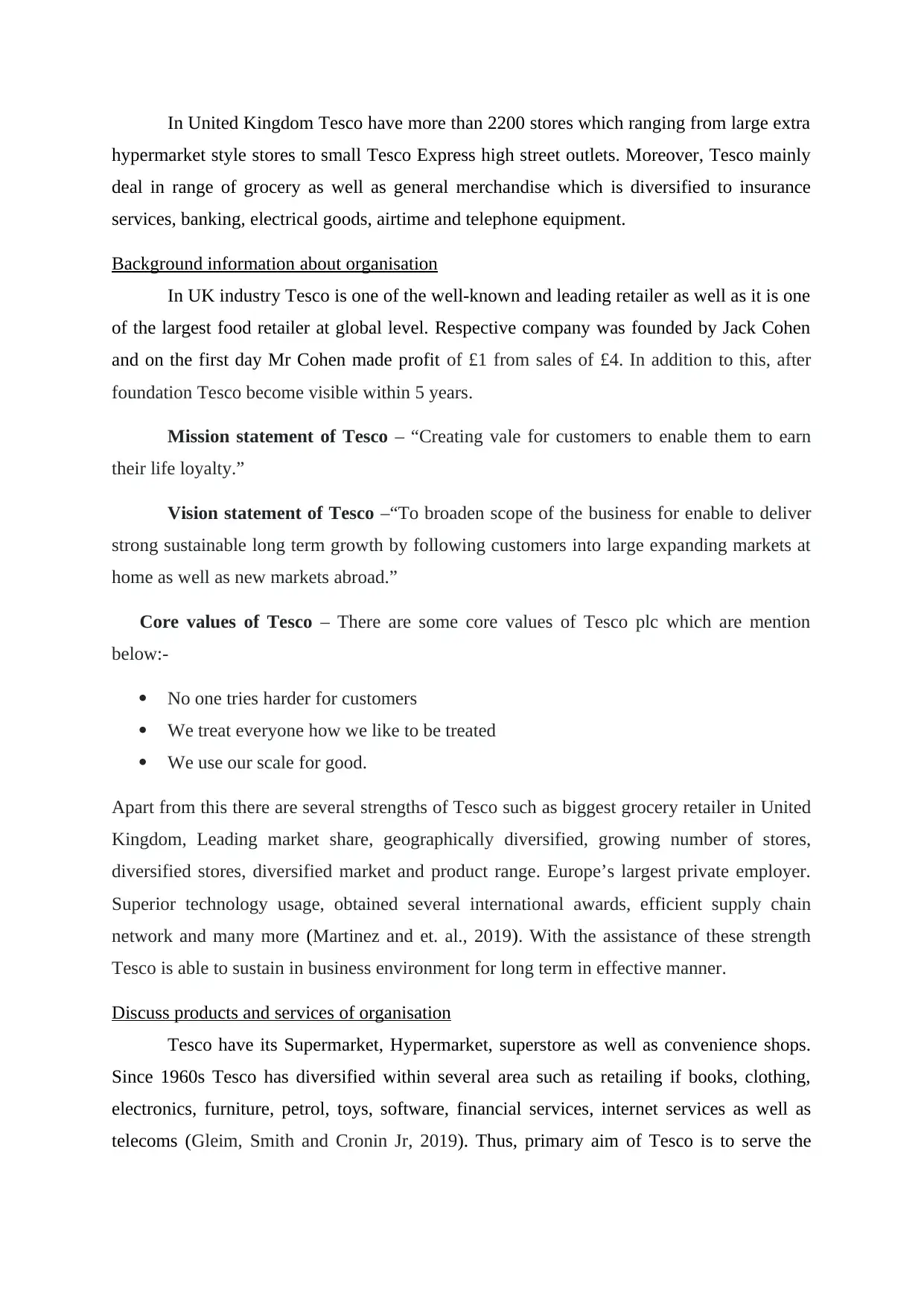
In United Kingdom Tesco have more than 2200 stores which ranging from large extra
hypermarket style stores to small Tesco Express high street outlets. Moreover, Tesco mainly
deal in range of grocery as well as general merchandise which is diversified to insurance
services, banking, electrical goods, airtime and telephone equipment.
Background information about organisation
In UK industry Tesco is one of the well-known and leading retailer as well as it is one
of the largest food retailer at global level. Respective company was founded by Jack Cohen
and on the first day Mr Cohen made profit of £1 from sales of £4. In addition to this, after
foundation Tesco become visible within 5 years.
Mission statement of Tesco – “Creating vale for customers to enable them to earn
their life loyalty.”
Vision statement of Tesco –“To broaden scope of the business for enable to deliver
strong sustainable long term growth by following customers into large expanding markets at
home as well as new markets abroad.”
Core values of Tesco – There are some core values of Tesco plc which are mention
below:-
No one tries harder for customers
We treat everyone how we like to be treated
We use our scale for good.
Apart from this there are several strengths of Tesco such as biggest grocery retailer in United
Kingdom, Leading market share, geographically diversified, growing number of stores,
diversified stores, diversified market and product range. Europe’s largest private employer.
Superior technology usage, obtained several international awards, efficient supply chain
network and many more (Martinez and et. al., 2019). With the assistance of these strength
Tesco is able to sustain in business environment for long term in effective manner.
Discuss products and services of organisation
Tesco have its Supermarket, Hypermarket, superstore as well as convenience shops.
Since 1960s Tesco has diversified within several area such as retailing if books, clothing,
electronics, furniture, petrol, toys, software, financial services, internet services as well as
telecoms (Gleim, Smith and Cronin Jr, 2019). Thus, primary aim of Tesco is to serve the
hypermarket style stores to small Tesco Express high street outlets. Moreover, Tesco mainly
deal in range of grocery as well as general merchandise which is diversified to insurance
services, banking, electrical goods, airtime and telephone equipment.
Background information about organisation
In UK industry Tesco is one of the well-known and leading retailer as well as it is one
of the largest food retailer at global level. Respective company was founded by Jack Cohen
and on the first day Mr Cohen made profit of £1 from sales of £4. In addition to this, after
foundation Tesco become visible within 5 years.
Mission statement of Tesco – “Creating vale for customers to enable them to earn
their life loyalty.”
Vision statement of Tesco –“To broaden scope of the business for enable to deliver
strong sustainable long term growth by following customers into large expanding markets at
home as well as new markets abroad.”
Core values of Tesco – There are some core values of Tesco plc which are mention
below:-
No one tries harder for customers
We treat everyone how we like to be treated
We use our scale for good.
Apart from this there are several strengths of Tesco such as biggest grocery retailer in United
Kingdom, Leading market share, geographically diversified, growing number of stores,
diversified stores, diversified market and product range. Europe’s largest private employer.
Superior technology usage, obtained several international awards, efficient supply chain
network and many more (Martinez and et. al., 2019). With the assistance of these strength
Tesco is able to sustain in business environment for long term in effective manner.
Discuss products and services of organisation
Tesco have its Supermarket, Hypermarket, superstore as well as convenience shops.
Since 1960s Tesco has diversified within several area such as retailing if books, clothing,
electronics, furniture, petrol, toys, software, financial services, internet services as well as
telecoms (Gleim, Smith and Cronin Jr, 2019). Thus, primary aim of Tesco is to serve the
Secure Best Marks with AI Grader
Need help grading? Try our AI Grader for instant feedback on your assignments.
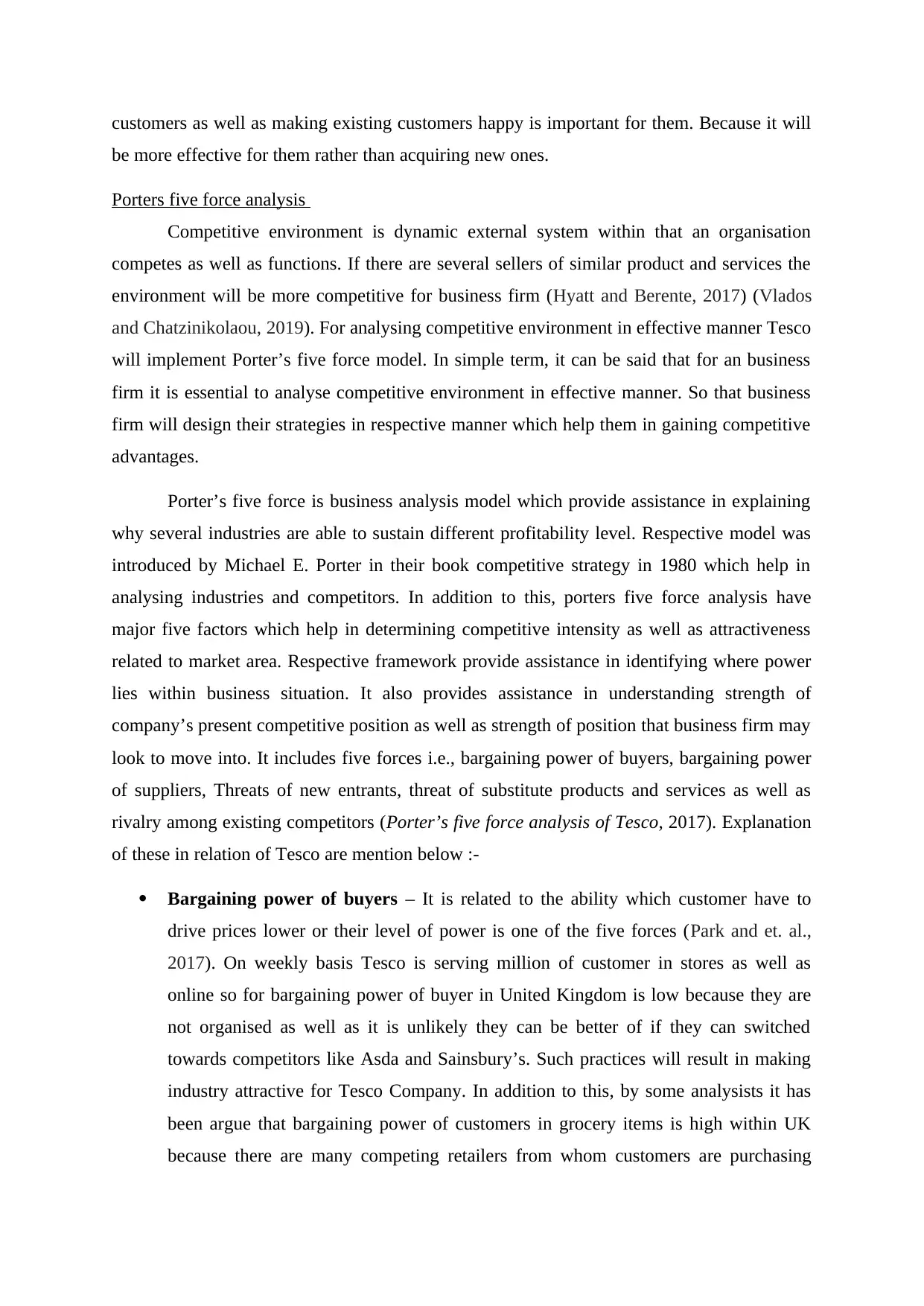
customers as well as making existing customers happy is important for them. Because it will
be more effective for them rather than acquiring new ones.
Porters five force analysis
Competitive environment is dynamic external system within that an organisation
competes as well as functions. If there are several sellers of similar product and services the
environment will be more competitive for business firm (Hyatt and Berente, 2017) (Vlados
and Chatzinikolaou, 2019). For analysing competitive environment in effective manner Tesco
will implement Porter’s five force model. In simple term, it can be said that for an business
firm it is essential to analyse competitive environment in effective manner. So that business
firm will design their strategies in respective manner which help them in gaining competitive
advantages.
Porter’s five force is business analysis model which provide assistance in explaining
why several industries are able to sustain different profitability level. Respective model was
introduced by Michael E. Porter in their book competitive strategy in 1980 which help in
analysing industries and competitors. In addition to this, porters five force analysis have
major five factors which help in determining competitive intensity as well as attractiveness
related to market area. Respective framework provide assistance in identifying where power
lies within business situation. It also provides assistance in understanding strength of
company’s present competitive position as well as strength of position that business firm may
look to move into. It includes five forces i.e., bargaining power of buyers, bargaining power
of suppliers, Threats of new entrants, threat of substitute products and services as well as
rivalry among existing competitors (Porter’s five force analysis of Tesco, 2017). Explanation
of these in relation of Tesco are mention below :-
Bargaining power of buyers – It is related to the ability which customer have to
drive prices lower or their level of power is one of the five forces (Park and et. al.,
2017). On weekly basis Tesco is serving million of customer in stores as well as
online so for bargaining power of buyer in United Kingdom is low because they are
not organised as well as it is unlikely they can be better of if they can switched
towards competitors like Asda and Sainsbury’s. Such practices will result in making
industry attractive for Tesco Company. In addition to this, by some analysists it has
been argue that bargaining power of customers in grocery items is high within UK
because there are many competing retailers from whom customers are purchasing
be more effective for them rather than acquiring new ones.
Porters five force analysis
Competitive environment is dynamic external system within that an organisation
competes as well as functions. If there are several sellers of similar product and services the
environment will be more competitive for business firm (Hyatt and Berente, 2017) (Vlados
and Chatzinikolaou, 2019). For analysing competitive environment in effective manner Tesco
will implement Porter’s five force model. In simple term, it can be said that for an business
firm it is essential to analyse competitive environment in effective manner. So that business
firm will design their strategies in respective manner which help them in gaining competitive
advantages.
Porter’s five force is business analysis model which provide assistance in explaining
why several industries are able to sustain different profitability level. Respective model was
introduced by Michael E. Porter in their book competitive strategy in 1980 which help in
analysing industries and competitors. In addition to this, porters five force analysis have
major five factors which help in determining competitive intensity as well as attractiveness
related to market area. Respective framework provide assistance in identifying where power
lies within business situation. It also provides assistance in understanding strength of
company’s present competitive position as well as strength of position that business firm may
look to move into. It includes five forces i.e., bargaining power of buyers, bargaining power
of suppliers, Threats of new entrants, threat of substitute products and services as well as
rivalry among existing competitors (Porter’s five force analysis of Tesco, 2017). Explanation
of these in relation of Tesco are mention below :-
Bargaining power of buyers – It is related to the ability which customer have to
drive prices lower or their level of power is one of the five forces (Park and et. al.,
2017). On weekly basis Tesco is serving million of customer in stores as well as
online so for bargaining power of buyer in United Kingdom is low because they are
not organised as well as it is unlikely they can be better of if they can switched
towards competitors like Asda and Sainsbury’s. Such practices will result in making
industry attractive for Tesco Company. In addition to this, by some analysists it has
been argue that bargaining power of customers in grocery items is high within UK
because there are many competing retailers from whom customers are purchasing
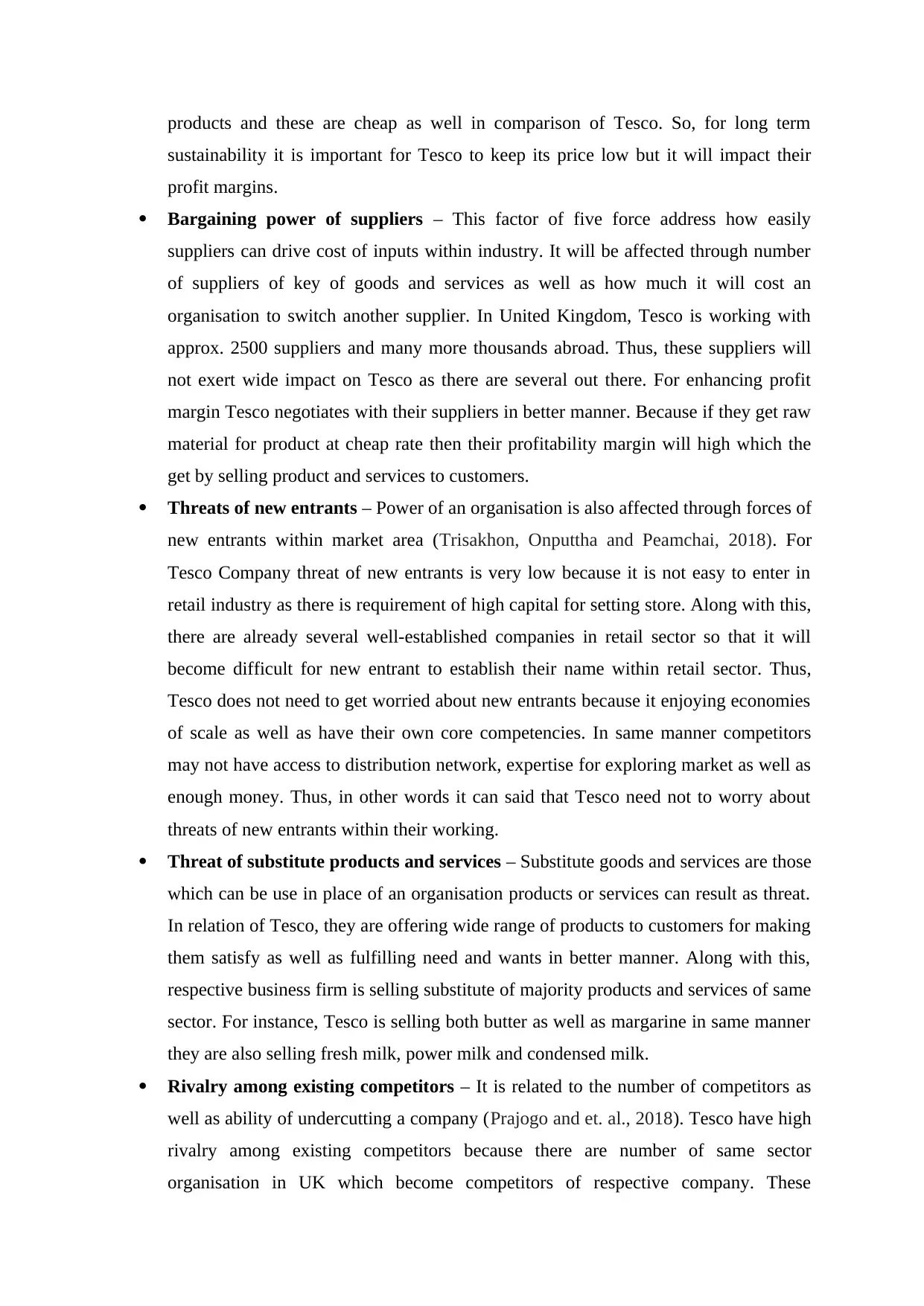
products and these are cheap as well in comparison of Tesco. So, for long term
sustainability it is important for Tesco to keep its price low but it will impact their
profit margins.
Bargaining power of suppliers – This factor of five force address how easily
suppliers can drive cost of inputs within industry. It will be affected through number
of suppliers of key of goods and services as well as how much it will cost an
organisation to switch another supplier. In United Kingdom, Tesco is working with
approx. 2500 suppliers and many more thousands abroad. Thus, these suppliers will
not exert wide impact on Tesco as there are several out there. For enhancing profit
margin Tesco negotiates with their suppliers in better manner. Because if they get raw
material for product at cheap rate then their profitability margin will high which the
get by selling product and services to customers.
Threats of new entrants – Power of an organisation is also affected through forces of
new entrants within market area (Trisakhon, Onputtha and Peamchai, 2018). For
Tesco Company threat of new entrants is very low because it is not easy to enter in
retail industry as there is requirement of high capital for setting store. Along with this,
there are already several well-established companies in retail sector so that it will
become difficult for new entrant to establish their name within retail sector. Thus,
Tesco does not need to get worried about new entrants because it enjoying economies
of scale as well as have their own core competencies. In same manner competitors
may not have access to distribution network, expertise for exploring market as well as
enough money. Thus, in other words it can said that Tesco need not to worry about
threats of new entrants within their working.
Threat of substitute products and services – Substitute goods and services are those
which can be use in place of an organisation products or services can result as threat.
In relation of Tesco, they are offering wide range of products to customers for making
them satisfy as well as fulfilling need and wants in better manner. Along with this,
respective business firm is selling substitute of majority products and services of same
sector. For instance, Tesco is selling both butter as well as margarine in same manner
they are also selling fresh milk, power milk and condensed milk.
Rivalry among existing competitors – It is related to the number of competitors as
well as ability of undercutting a company (Prajogo and et. al., 2018). Tesco have high
rivalry among existing competitors because there are number of same sector
organisation in UK which become competitors of respective company. These
sustainability it is important for Tesco to keep its price low but it will impact their
profit margins.
Bargaining power of suppliers – This factor of five force address how easily
suppliers can drive cost of inputs within industry. It will be affected through number
of suppliers of key of goods and services as well as how much it will cost an
organisation to switch another supplier. In United Kingdom, Tesco is working with
approx. 2500 suppliers and many more thousands abroad. Thus, these suppliers will
not exert wide impact on Tesco as there are several out there. For enhancing profit
margin Tesco negotiates with their suppliers in better manner. Because if they get raw
material for product at cheap rate then their profitability margin will high which the
get by selling product and services to customers.
Threats of new entrants – Power of an organisation is also affected through forces of
new entrants within market area (Trisakhon, Onputtha and Peamchai, 2018). For
Tesco Company threat of new entrants is very low because it is not easy to enter in
retail industry as there is requirement of high capital for setting store. Along with this,
there are already several well-established companies in retail sector so that it will
become difficult for new entrant to establish their name within retail sector. Thus,
Tesco does not need to get worried about new entrants because it enjoying economies
of scale as well as have their own core competencies. In same manner competitors
may not have access to distribution network, expertise for exploring market as well as
enough money. Thus, in other words it can said that Tesco need not to worry about
threats of new entrants within their working.
Threat of substitute products and services – Substitute goods and services are those
which can be use in place of an organisation products or services can result as threat.
In relation of Tesco, they are offering wide range of products to customers for making
them satisfy as well as fulfilling need and wants in better manner. Along with this,
respective business firm is selling substitute of majority products and services of same
sector. For instance, Tesco is selling both butter as well as margarine in same manner
they are also selling fresh milk, power milk and condensed milk.
Rivalry among existing competitors – It is related to the number of competitors as
well as ability of undercutting a company (Prajogo and et. al., 2018). Tesco have high
rivalry among existing competitors because there are number of same sector
organisation in UK which become competitors of respective company. These

competitors are spending highly on advertising as well as other marketing techniques
for gaining competitive advantages in better manner. Thus, Tesco is market leader in
retail industry as pressure from the nearest rivals is intense. But profit margin of
respective company getting affected through price wars launched by Aldi and Lidl.
Thus, for this Tesco exploring suitable solution for tackling issues related to intense
competition. For example, Jack opened discount chain in 2018 for competing with
Lidl and Aldi. However, performance of company has been poor because of several
reason such as few stores, job losses, disappointing sales and many more.
Porter’s value chain
Michael Porter’s Value chain is one of the most valued concepts within today’s
market because Value chain tell that how company can differentiate their products by
analysing the event chain that occur in company. Within todays saturated market area
differentiation, it very essential that Porter’s Value Chain referred by lot of organisations. In
addition to this, according to the concept of porter’s value chain says that there is chain of
events which occur within cooperation right from the procurement related of raw materials to
delivery of goods and post sales services (Roscoe and et. al., 2020). Along with this, first 5
are the primary activities that are generally basic within company and these activities result in
strength and sustainability of firm. On the other hand, 4 remaining activities are known as
secondary activities and these will be use by business firm for differentiation as well as
maintenance of company. Both primary and secondary activities are important for survival of
business firm. Here, primary activities are inbound logistics, operations, outbound logistics,
marketing & sales, procurement, service and many more. On the other hand, secondary
activities involve firm infrastructure, human resource management, technology development
and many more.
Through porter’s value chain model, it has been identified that there are some value
adding activities which provide assistance to Tesco in managing their activities within
effective manner as well as also help in gaining competitive advantages (Inoni, Salami and
Olannye, 2019). There activities mainly include Human resource management because this
division help in managing activity of company in better manneinto three r and also enhance
productivity of Tesco through motivating staff members. In addition to this, marketing &
sales also result in adding value to company as effective sales and marketing result in
attracting customers and increasing sales of company. Along with this, there are several other
for gaining competitive advantages in better manner. Thus, Tesco is market leader in
retail industry as pressure from the nearest rivals is intense. But profit margin of
respective company getting affected through price wars launched by Aldi and Lidl.
Thus, for this Tesco exploring suitable solution for tackling issues related to intense
competition. For example, Jack opened discount chain in 2018 for competing with
Lidl and Aldi. However, performance of company has been poor because of several
reason such as few stores, job losses, disappointing sales and many more.
Porter’s value chain
Michael Porter’s Value chain is one of the most valued concepts within today’s
market because Value chain tell that how company can differentiate their products by
analysing the event chain that occur in company. Within todays saturated market area
differentiation, it very essential that Porter’s Value Chain referred by lot of organisations. In
addition to this, according to the concept of porter’s value chain says that there is chain of
events which occur within cooperation right from the procurement related of raw materials to
delivery of goods and post sales services (Roscoe and et. al., 2020). Along with this, first 5
are the primary activities that are generally basic within company and these activities result in
strength and sustainability of firm. On the other hand, 4 remaining activities are known as
secondary activities and these will be use by business firm for differentiation as well as
maintenance of company. Both primary and secondary activities are important for survival of
business firm. Here, primary activities are inbound logistics, operations, outbound logistics,
marketing & sales, procurement, service and many more. On the other hand, secondary
activities involve firm infrastructure, human resource management, technology development
and many more.
Through porter’s value chain model, it has been identified that there are some value
adding activities which provide assistance to Tesco in managing their activities within
effective manner as well as also help in gaining competitive advantages (Inoni, Salami and
Olannye, 2019). There activities mainly include Human resource management because this
division help in managing activity of company in better manneinto three r and also enhance
productivity of Tesco through motivating staff members. In addition to this, marketing &
sales also result in adding value to company as effective sales and marketing result in
attracting customers and increasing sales of company. Along with this, there are several other
Paraphrase This Document
Need a fresh take? Get an instant paraphrase of this document with our AI Paraphraser

activities also which provide assistance in adding value to operations of company and also in
enhancing sale.
Primary Activities
Inbound Logistics: Tesco makes investments regularly, in order to increase the overall
capacity of its logistics. Although, the company has an image of treating its suppliers poorly
and it is also said that the suppliers mostly see a delay in their payments (Damanpour,
Sanchez‐Henriquez and Chiu, 2018). Therefore, it is important that Tesco maintains good
relations with its suppliers in order to maintain its overall performance as the suppliers will
help in the process. If the respective company fails to manage its inbound logistics
effectively, it will have to suffer the consequences.
Operations: The operations of Tesco can broadly be classified into three categories
namely, retail, manufacturing and banking. The retail segment of the company represents the
core business activities of Tesco. The company operates its stores in the format of Metro,
Express, Superstore and Extra. Metro stores are known for selling a wide range of food and a
smaller section of general merchandise. On the other hand, Extra stores offer the highest
choices of products which also includes electric appliances and health services. The company
also manufactures products and sells them to the customers under the brand name of
Everyday Value. Apart from this, Tesco Bank is a bank that is owned by Tesco itself.
Outbound Logistics: The main sources of value for Tesco are flexibility and cost-
effectiveness. The supermarket chain also offers several options for home delivery for the
purchases that are made online. Activities in outbound logistics mainly include the delivery
of final products to the customers through different intermediaries. The different activities
included in this are scheduling, warehousing, transporting and delivery. If Tesco manages
these activities effectively, it will be able to gain the trust of customers as well as satisfy their
needs. Also, the products will reach to the end customers in the most efficient way.
Therefore, the company should pay focus on making sure that the products reach the
customers as quickly as possible.
Support Activities
Technology Development: All organizations these days, incorporate technology into
their systems in order to make their value chains more efficient (Moyano-Fuentes, Sacristán-
Díaz and Garrido-Vega, 2016). Tesco understands the importance of technology, which is
why it has been able to maintain its position in the market. Technology helps the company in
enhancing sale.
Primary Activities
Inbound Logistics: Tesco makes investments regularly, in order to increase the overall
capacity of its logistics. Although, the company has an image of treating its suppliers poorly
and it is also said that the suppliers mostly see a delay in their payments (Damanpour,
Sanchez‐Henriquez and Chiu, 2018). Therefore, it is important that Tesco maintains good
relations with its suppliers in order to maintain its overall performance as the suppliers will
help in the process. If the respective company fails to manage its inbound logistics
effectively, it will have to suffer the consequences.
Operations: The operations of Tesco can broadly be classified into three categories
namely, retail, manufacturing and banking. The retail segment of the company represents the
core business activities of Tesco. The company operates its stores in the format of Metro,
Express, Superstore and Extra. Metro stores are known for selling a wide range of food and a
smaller section of general merchandise. On the other hand, Extra stores offer the highest
choices of products which also includes electric appliances and health services. The company
also manufactures products and sells them to the customers under the brand name of
Everyday Value. Apart from this, Tesco Bank is a bank that is owned by Tesco itself.
Outbound Logistics: The main sources of value for Tesco are flexibility and cost-
effectiveness. The supermarket chain also offers several options for home delivery for the
purchases that are made online. Activities in outbound logistics mainly include the delivery
of final products to the customers through different intermediaries. The different activities
included in this are scheduling, warehousing, transporting and delivery. If Tesco manages
these activities effectively, it will be able to gain the trust of customers as well as satisfy their
needs. Also, the products will reach to the end customers in the most efficient way.
Therefore, the company should pay focus on making sure that the products reach the
customers as quickly as possible.
Support Activities
Technology Development: All organizations these days, incorporate technology into
their systems in order to make their value chains more efficient (Moyano-Fuentes, Sacristán-
Díaz and Garrido-Vega, 2016). Tesco understands the importance of technology, which is
why it has been able to maintain its position in the market. Technology helps the company in
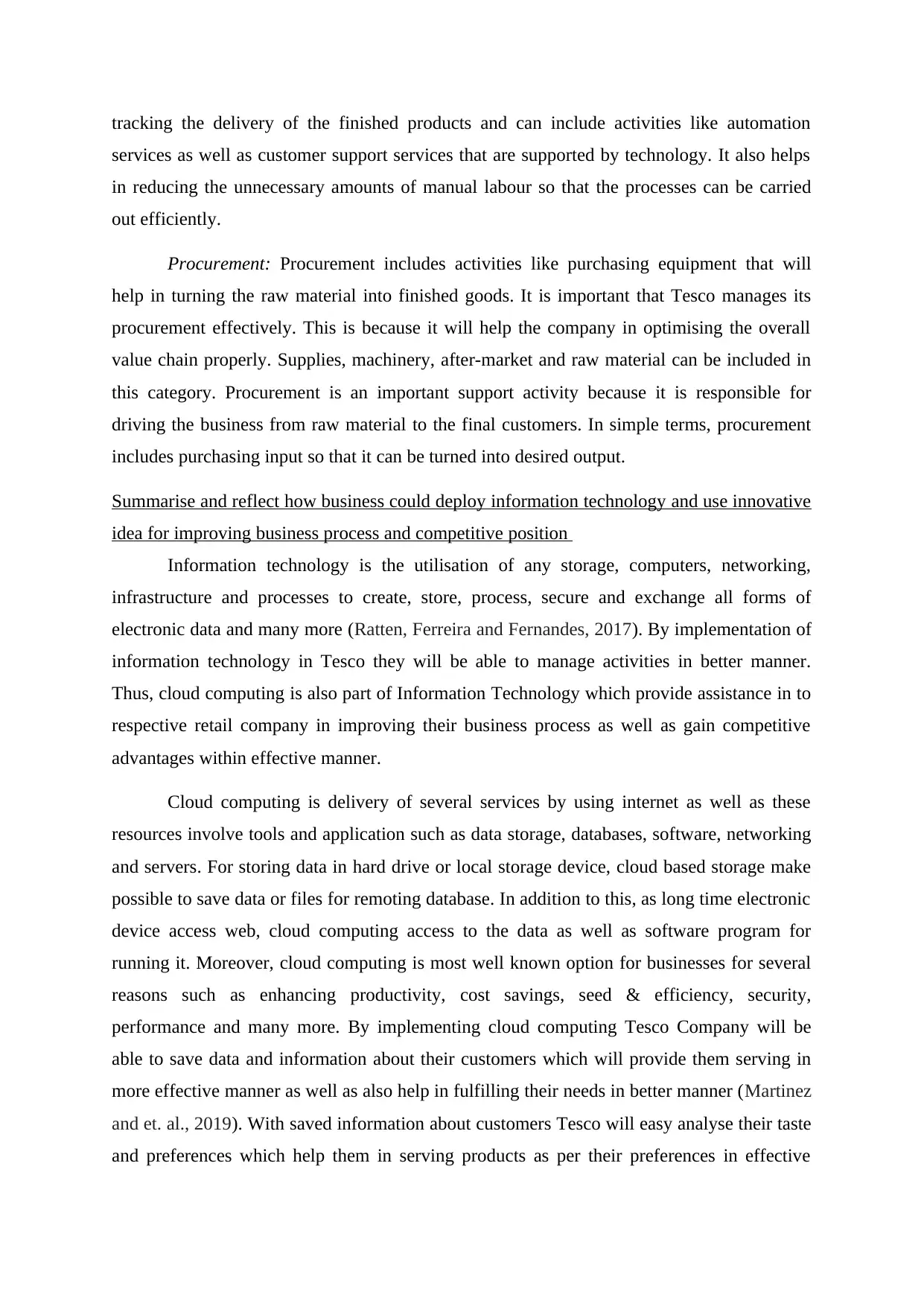
tracking the delivery of the finished products and can include activities like automation
services as well as customer support services that are supported by technology. It also helps
in reducing the unnecessary amounts of manual labour so that the processes can be carried
out efficiently.
Procurement: Procurement includes activities like purchasing equipment that will
help in turning the raw material into finished goods. It is important that Tesco manages its
procurement effectively. This is because it will help the company in optimising the overall
value chain properly. Supplies, machinery, after-market and raw material can be included in
this category. Procurement is an important support activity because it is responsible for
driving the business from raw material to the final customers. In simple terms, procurement
includes purchasing input so that it can be turned into desired output.
Summarise and reflect how business could deploy information technology and use innovative
idea for improving business process and competitive position
Information technology is the utilisation of any storage, computers, networking,
infrastructure and processes to create, store, process, secure and exchange all forms of
electronic data and many more (Ratten, Ferreira and Fernandes, 2017). By implementation of
information technology in Tesco they will be able to manage activities in better manner.
Thus, cloud computing is also part of Information Technology which provide assistance in to
respective retail company in improving their business process as well as gain competitive
advantages within effective manner.
Cloud computing is delivery of several services by using internet as well as these
resources involve tools and application such as data storage, databases, software, networking
and servers. For storing data in hard drive or local storage device, cloud based storage make
possible to save data or files for remoting database. In addition to this, as long time electronic
device access web, cloud computing access to the data as well as software program for
running it. Moreover, cloud computing is most well known option for businesses for several
reasons such as enhancing productivity, cost savings, seed & efficiency, security,
performance and many more. By implementing cloud computing Tesco Company will be
able to save data and information about their customers which will provide them serving in
more effective manner as well as also help in fulfilling their needs in better manner (Martinez
and et. al., 2019). With saved information about customers Tesco will easy analyse their taste
and preferences which help them in serving products as per their preferences in effective
services as well as customer support services that are supported by technology. It also helps
in reducing the unnecessary amounts of manual labour so that the processes can be carried
out efficiently.
Procurement: Procurement includes activities like purchasing equipment that will
help in turning the raw material into finished goods. It is important that Tesco manages its
procurement effectively. This is because it will help the company in optimising the overall
value chain properly. Supplies, machinery, after-market and raw material can be included in
this category. Procurement is an important support activity because it is responsible for
driving the business from raw material to the final customers. In simple terms, procurement
includes purchasing input so that it can be turned into desired output.
Summarise and reflect how business could deploy information technology and use innovative
idea for improving business process and competitive position
Information technology is the utilisation of any storage, computers, networking,
infrastructure and processes to create, store, process, secure and exchange all forms of
electronic data and many more (Ratten, Ferreira and Fernandes, 2017). By implementation of
information technology in Tesco they will be able to manage activities in better manner.
Thus, cloud computing is also part of Information Technology which provide assistance in to
respective retail company in improving their business process as well as gain competitive
advantages within effective manner.
Cloud computing is delivery of several services by using internet as well as these
resources involve tools and application such as data storage, databases, software, networking
and servers. For storing data in hard drive or local storage device, cloud based storage make
possible to save data or files for remoting database. In addition to this, as long time electronic
device access web, cloud computing access to the data as well as software program for
running it. Moreover, cloud computing is most well known option for businesses for several
reasons such as enhancing productivity, cost savings, seed & efficiency, security,
performance and many more. By implementing cloud computing Tesco Company will be
able to save data and information about their customers which will provide them serving in
more effective manner as well as also help in fulfilling their needs in better manner (Martinez
and et. al., 2019). With saved information about customers Tesco will easy analyse their taste
and preferences which help them in serving products as per their preferences in effective
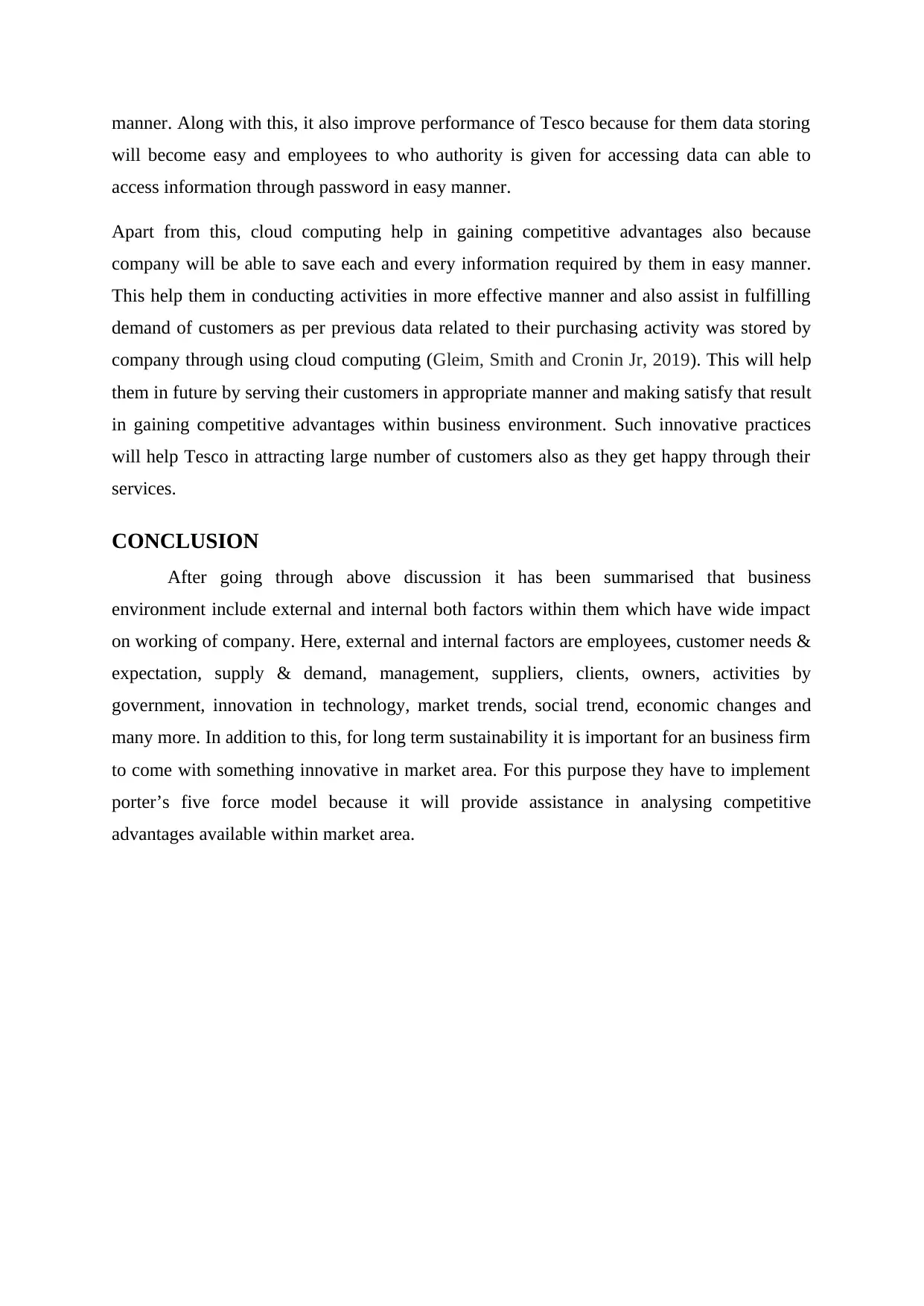
manner. Along with this, it also improve performance of Tesco because for them data storing
will become easy and employees to who authority is given for accessing data can able to
access information through password in easy manner.
Apart from this, cloud computing help in gaining competitive advantages also because
company will be able to save each and every information required by them in easy manner.
This help them in conducting activities in more effective manner and also assist in fulfilling
demand of customers as per previous data related to their purchasing activity was stored by
company through using cloud computing (Gleim, Smith and Cronin Jr, 2019). This will help
them in future by serving their customers in appropriate manner and making satisfy that result
in gaining competitive advantages within business environment. Such innovative practices
will help Tesco in attracting large number of customers also as they get happy through their
services.
CONCLUSION
After going through above discussion it has been summarised that business
environment include external and internal both factors within them which have wide impact
on working of company. Here, external and internal factors are employees, customer needs &
expectation, supply & demand, management, suppliers, clients, owners, activities by
government, innovation in technology, market trends, social trend, economic changes and
many more. In addition to this, for long term sustainability it is important for an business firm
to come with something innovative in market area. For this purpose they have to implement
porter’s five force model because it will provide assistance in analysing competitive
advantages available within market area.
will become easy and employees to who authority is given for accessing data can able to
access information through password in easy manner.
Apart from this, cloud computing help in gaining competitive advantages also because
company will be able to save each and every information required by them in easy manner.
This help them in conducting activities in more effective manner and also assist in fulfilling
demand of customers as per previous data related to their purchasing activity was stored by
company through using cloud computing (Gleim, Smith and Cronin Jr, 2019). This will help
them in future by serving their customers in appropriate manner and making satisfy that result
in gaining competitive advantages within business environment. Such innovative practices
will help Tesco in attracting large number of customers also as they get happy through their
services.
CONCLUSION
After going through above discussion it has been summarised that business
environment include external and internal both factors within them which have wide impact
on working of company. Here, external and internal factors are employees, customer needs &
expectation, supply & demand, management, suppliers, clients, owners, activities by
government, innovation in technology, market trends, social trend, economic changes and
many more. In addition to this, for long term sustainability it is important for an business firm
to come with something innovative in market area. For this purpose they have to implement
porter’s five force model because it will provide assistance in analysing competitive
advantages available within market area.
Secure Best Marks with AI Grader
Need help grading? Try our AI Grader for instant feedback on your assignments.

REFERENCES
Books and Journals
Janković, M., Mihajlović, M. and Cvetković, T., 2016. Influence of external factors on
business of companies in Serbia. Ekonomika, 62(4), pp.31-38.
Ratten, V., Ferreira, J. J. and Fernandes, C. I., 2017. Balkans entrepreneurship: the role of
internal and external knowledge for business creation. World Review of Entrepreneurship,
Management and Sustainable Development, 13(2-3), pp.126-140.
Martinez, M. G. and et. al., 2019. What drives business failure? Exploring the role of internal
and external knowledge capabilities during the global financial crisis. Journal of Business
Research, 98, pp.441-449.
Gleim, M. R., Smith, J. S. and Cronin Jr, J. J., 2019. Extending the institutional environment:
the impact of internal and external factors on the green behaviors of an individual. Journal of
Strategic Marketing, 27(6), pp.505-520.
Hyatt, D. G. and Berente, N., 2017. Substantive or symbolic environmental strategies?
Effects of external and internal normative stakeholder pressures. Business Strategy and the
Environment, 26(8), pp.1212-1234.
Vlados, C. and Chatzinikolaou, D., 2019. Methodological redirections for an evolutionary
approach of the external business environment. Journal of Management and
Sustainability, 9(2), pp.25-46.
Park, J. and et. al., 2017. Alignment between internal and external IT governance and its
effects on distinctive firm performance: An extended resource-based view. IEEE
Transactions on Engineering Management, 64(3), pp.351-364.
Trisakhon, C., Onputtha, S. O. and Peamchai, P., 2018. The Effect of External Business
Environment on Business Performance of Small and Medium Food Processing Enterprises in
Bangkok and Metropolitan Area. International Journal of Applied Computer Technology and
Information Systems, 8(1).
Prajogo, D. and et. al., 2018. The relationships between information management, process
management and operational performance: Internal and external contexts. International
Journal of Production Economics, 199, pp.95-103.
Roscoe, S. and et. al., 2020. Determining how internal and external process connectivity
affect supply chain agility: a life-cycle theory perspective. Production Planning &
Control, 31(1), pp.78-91.
Inoni, O. R., Salami, C. G. E. and Olannye, A. P., 2019. Effects of Internal and External
Factors on Organizational Buying Behaviour: A Review of Extant Literature. Izvestiya, (3),
pp.216-237.
Damanpour, F., Sanchez‐Henriquez, F. and Chiu, H. H., 2018. Internal and external sources
and the adoption of innovations in organizations. British Journal of Management, 29(4),
pp.712-730.
Moyano-Fuentes, J., Sacristán-Díaz, M. and Garrido-Vega, P., 2016. Improving supply chain
responsiveness through advanced manufacturing technology: the mediating role of internal
and external integration. Production Planning & Control, 27(9), pp.686-697.
Books and Journals
Janković, M., Mihajlović, M. and Cvetković, T., 2016. Influence of external factors on
business of companies in Serbia. Ekonomika, 62(4), pp.31-38.
Ratten, V., Ferreira, J. J. and Fernandes, C. I., 2017. Balkans entrepreneurship: the role of
internal and external knowledge for business creation. World Review of Entrepreneurship,
Management and Sustainable Development, 13(2-3), pp.126-140.
Martinez, M. G. and et. al., 2019. What drives business failure? Exploring the role of internal
and external knowledge capabilities during the global financial crisis. Journal of Business
Research, 98, pp.441-449.
Gleim, M. R., Smith, J. S. and Cronin Jr, J. J., 2019. Extending the institutional environment:
the impact of internal and external factors on the green behaviors of an individual. Journal of
Strategic Marketing, 27(6), pp.505-520.
Hyatt, D. G. and Berente, N., 2017. Substantive or symbolic environmental strategies?
Effects of external and internal normative stakeholder pressures. Business Strategy and the
Environment, 26(8), pp.1212-1234.
Vlados, C. and Chatzinikolaou, D., 2019. Methodological redirections for an evolutionary
approach of the external business environment. Journal of Management and
Sustainability, 9(2), pp.25-46.
Park, J. and et. al., 2017. Alignment between internal and external IT governance and its
effects on distinctive firm performance: An extended resource-based view. IEEE
Transactions on Engineering Management, 64(3), pp.351-364.
Trisakhon, C., Onputtha, S. O. and Peamchai, P., 2018. The Effect of External Business
Environment on Business Performance of Small and Medium Food Processing Enterprises in
Bangkok and Metropolitan Area. International Journal of Applied Computer Technology and
Information Systems, 8(1).
Prajogo, D. and et. al., 2018. The relationships between information management, process
management and operational performance: Internal and external contexts. International
Journal of Production Economics, 199, pp.95-103.
Roscoe, S. and et. al., 2020. Determining how internal and external process connectivity
affect supply chain agility: a life-cycle theory perspective. Production Planning &
Control, 31(1), pp.78-91.
Inoni, O. R., Salami, C. G. E. and Olannye, A. P., 2019. Effects of Internal and External
Factors on Organizational Buying Behaviour: A Review of Extant Literature. Izvestiya, (3),
pp.216-237.
Damanpour, F., Sanchez‐Henriquez, F. and Chiu, H. H., 2018. Internal and external sources
and the adoption of innovations in organizations. British Journal of Management, 29(4),
pp.712-730.
Moyano-Fuentes, J., Sacristán-Díaz, M. and Garrido-Vega, P., 2016. Improving supply chain
responsiveness through advanced manufacturing technology: the mediating role of internal
and external integration. Production Planning & Control, 27(9), pp.686-697.
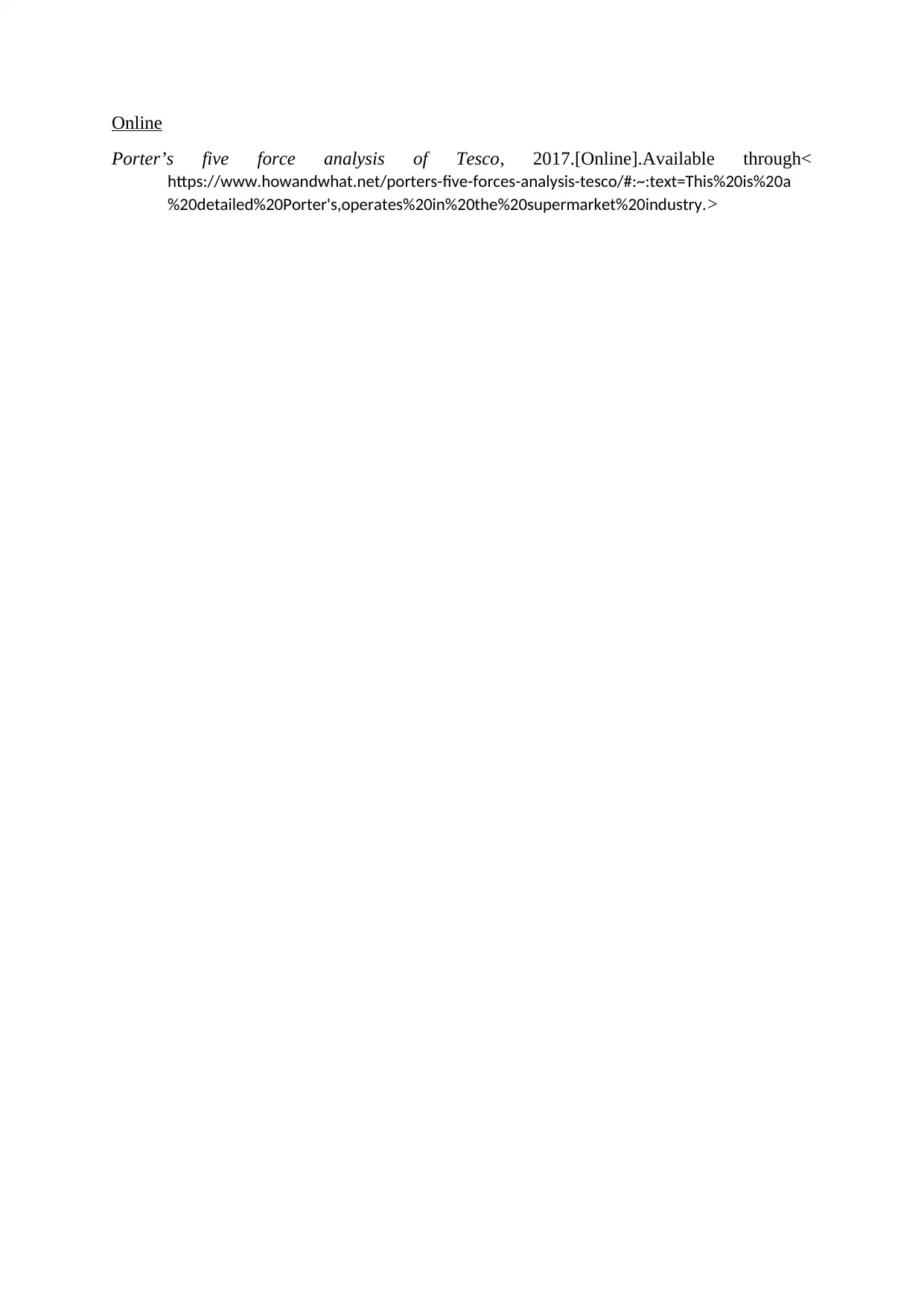
Online
Porter’s five force analysis of Tesco, 2017.[Online].Available through<
https://www.howandwhat.net/porters-five-forces-analysis-tesco/#:~:text=This%20is%20a
%20detailed%20Porter's,operates%20in%20the%20supermarket%20industry.>
Porter’s five force analysis of Tesco, 2017.[Online].Available through<
https://www.howandwhat.net/porters-five-forces-analysis-tesco/#:~:text=This%20is%20a
%20detailed%20Porter's,operates%20in%20the%20supermarket%20industry.>
1 out of 12
Related Documents
Your All-in-One AI-Powered Toolkit for Academic Success.
+13062052269
info@desklib.com
Available 24*7 on WhatsApp / Email
![[object Object]](/_next/static/media/star-bottom.7253800d.svg)
Unlock your academic potential
© 2024 | Zucol Services PVT LTD | All rights reserved.





